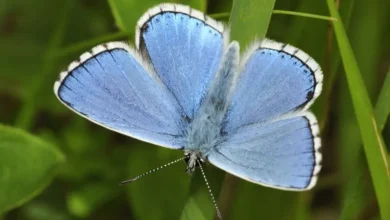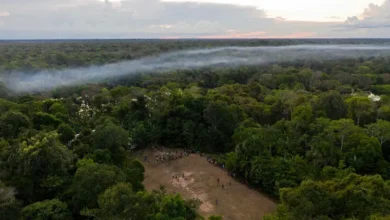Grímsey: The Arctic island with 20 people and one million birds

Set some 40km off Iceland’s northern coast, this windswept sliver is home to one of Europe’s most remote settlements and a thriving seabird population.
Even on a sunny day in late August, the wind on the island of Grímsey cut through our waterproof layers with so much force that one bad gust felt as if it could wipe us clean off the map for good.
My husband and I arrived on Grímsey’s beautiful, blustery shores carrying a couple of wooden walking sticks – not so much to help us keep our balance against the elements, but rather to ward off the Arctic terns that are notorious for dive-bombing unassuming tourists who wander too close to their nests along the craggy coastline. As we slowly walked around the island’s dramatic basalt cliffs, we also noticed a few puffin stragglers who had yet to migrate out to sea before returning to Grímsey in full force come April.
A 6.5-sq-km island set some 40km off Iceland’s northern coast, Grímsey is the country’s northernmost inhabited point and the only sliver of Iceland located within the Arctic Circle. In many ways, this frigid far-flung isle cast off a frigid far-flung island nation is Iceland at its most elusive and extreme – and therein lies its appeal.

Until 1931, the only way to reach Grímsey was by hopping aboard a small boat that delivered letters twice a year to the island. These days, 20-minute flights from the city of Akureyri and three-hour ferries from the village of Dalvík whisk adventure-seekers to this rocky, remote island – most of whom, like us, are keen to see one of Europe’s most remote settlements and its incredible variety of seabirds and wildlife. In addition to the kamikaze Arctic terns and a thriving puffin population, black-legged kittiwakes, razorbills and guillemots – along with free-roaming Icelandic horses and sheep – also call this idyllic island home. It’s estimated the seabirds here outnumber residents by roughly 50,000 to one.
“You won’t believe it, but there are only 20 of us living here full time,” explained Halla Ingolfsdottir, a local tour guide and owner of Artic Trip.
Born in Reykjavík, Ingolfsdottir grew up in south-east Iceland and started spending extended stretches of time in Grímsey after visiting her sister, who moved to the island years earlier after meeting and marrying a local fisherman. After more than 20 years living part time in Grímsey, Ingolfsdottir said she decided to become a full-time resident in 2019, and she hasn’t looked back since.
“People think I moved here for love, but I fell in love with the island,” she explained. “There’s a magic, and I fell in love with how people lived here, the islanders and the nature. Nature is very powerful here; it’s a different natural force in the winter, and with the darkness comes the Northern Lights, the stars and the storms. In spring comes the light, and the birds; every season is special,” she added.

In addition to running a tour company, Ingolfsdottir also owns and operates a nine-room guesthouse out of her home. When she’s not leading tours and tending to her visitors, Ingolfsdottir stops by Grímsey’s power station once a day to ensure the island is generating enough electricity to keep things running. While mainland Iceland relies heavily on geothermal and renewable energy, Grímsey is so remote that it’s actually off the national power grid. Instead, the entire island runs on a single diesel-powered generator.
“People on my tours always ask if I get bored, but I have so much to do,” Ingolfsdottir said. “We do the same things as those who live on the mainland: we work, we go to the gym, we exercise, but it is nature that keeps me here.”
Visiting Grímsey
The most popular time to visit the island is from 10 April to 10 August, when puffins descend on Grímsey to nest in its cliffs. Arctic Trip offers guided birdwatching walking tours, while other operators run birdwatching boat tours.
There is no hospital, doctor or police station on Grímsey. In case of emergency, Ingolfsdottir says that the Coast Guard and emergency services have trained islanders to take action. “When you live here, you must learn to be flexible and adjust to different situations and scenarios,” Ingolfsdottir said. “We are prepared for anything. In case of an emergency, they train us to be ready for the first response, and a doctor comes to visit every three weeks by plane.”
A small collection of homes (many of which double as guesthouses for tourists) is located on the south-west side of the island. The settlement, known as Sandvík, also includes a schoolhouse that now functions as a community centre, as well as a handicraft gallery and cafe that offers homemade Icelandic wares, knits and other knickknacks. There is also a small grocery store that’s open for about an hour each day, as well as a restaurant with a bar, a swimming pool, library, church and the airstrip – which doubles as a popular landing spot for birds.

Like many small towns and villages in Iceland, Grímsey’s history is rooted in local lore. As the story goes, the island’s name is linked to a Norse settler named Grimur who is believed to have sailed from Western Norway’s Sogn district. The earliest known reference to Grímsey dates to 1024, as recorded in the Heimskringla, an ancient Icelandic saga in which King Ólafur of Norway requested Grímsey as a token of friendship. Local leaders refused, deeming the island too valuable to relinquish, thanks to its abundance of fish and birds.
By the late 18th Century, Grímsey’s population nearly collapsed due to pneumonia and fishing-related accidents – a combination of small rowboats, bad weather and lack of a natural harbour making landing here a risky pursuit. Still, the community endured, thanks to the steady stream of fishermen from the mainland and those who arrived to trade with the nearby settlement on Húsavík, located on Iceland’s northern coast.










